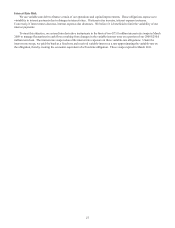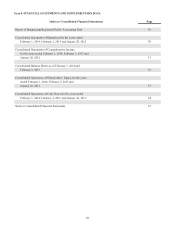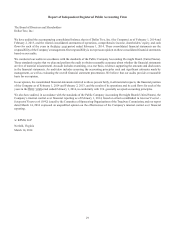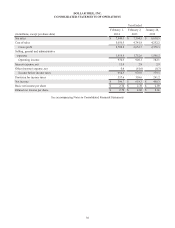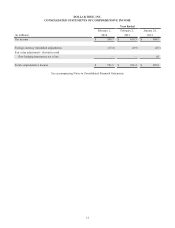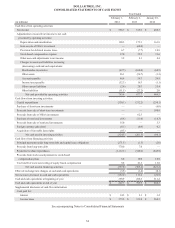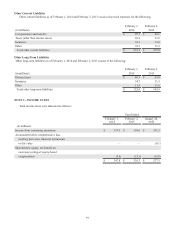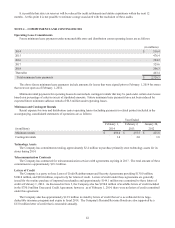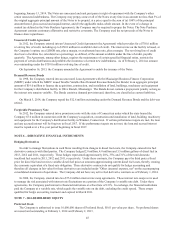Dollar Tree 2013 Annual Report Download - page 52
Download and view the complete annual report
Please find page 52 of the 2013 Dollar Tree annual report below. You can navigate through the pages in the report by either clicking on the pages listed below, or by using the keyword search tool below to find specific information within the annual report.36
Costs directly associated with warehousing and distribution are capitalized as merchandise inventories. Total warehousing
and distribution costs capitalized into inventory amounted to $43.2 million and $38.8 million at February 1, 2014 and
February 2, 2013, respectively.
Property, Plant and Equipment
Property, plant and equipment are stated at cost and depreciated using the straight-line method over the estimated useful
lives of the respective assets as follows:
Buildings 39 to 40 years
Furniture, fixtures and equipment 3 to 15 years
Leasehold improvements and assets held under capital leases are amortized over the estimated useful lives of the respective
assets or the committed terms of the related leases, whichever is shorter. Amortization is included in "selling, general and
administrative expenses" in the accompanying consolidated statements of operations.
Costs incurred related to software developed for internal use are capitalized and amortized, generally over 3 years.
Goodwill
Goodwill is not amortized, but rather tested for impairment at least annually. In addition, goodwill will be tested on an
interim basis if an event or circumstance indicates that it is more likely than not that an impairment loss has been incurred. The
Company performed its annual impairment testing in November 2013 and determined that no impairment loss existed.
Other Assets, Net
Other assets, net consists primarily of restricted investments, deferred compensation plan assets and deferred financing
costs. Restricted investments were $87.9 million and $94.6 million at February 1, 2014 and February 2, 2013, respectively and
were purchased to collateralize long-term insurance obligations. These investments are primarily in tax-exempt money market
funds that invest in short-term municipal obligations. These investments are classified as available for sale and are recorded at
fair value, which approximates cost. Deferred compensation plan assets were $5.1 million and $4.2 million at February 1, 2014
and February 2, 2013, respectively and are recorded at fair value. Deferred financing costs represent costs directly related to
debt issuances and are amortized over the terms of the related debt. Deferred financing costs, net of amortization, were $4.3
million and $1.7 million at February 1, 2014 and February 2, 2013, respectively.
Impairment of Long-Lived Assets and Long-Lived Assets to Be Disposed Of
The Company reviews its long-lived assets and certain identifiable intangible assets for impairment whenever events or
changes in circumstances indicate that the carrying amount of an asset may not be recoverable. Recoverability of assets to be
held and used is measured by comparing the carrying amount of an asset to future net undiscounted cash flows expected to be
generated by the asset. If such assets are considered to be impaired, the impairment to be recognized is measured as the
amount by which the carrying amount of the assets exceeds the fair value of the assets based on discounted cash flows or other
readily available evidence of fair value, if any. Assets to be disposed of are reported at the lower of the carrying amount or fair
value less costs to sell. In fiscal 2013, 2012 and 2011, the Company recorded charges of $0.5 million, $0.5 million and $0.9
million, respectively, to write down certain assets. These charges are recorded as a component of "selling, general and
administrative expenses" in the accompanying consolidated statements of operations.
Financial Instruments
The Company utilizes derivative financial instruments to reduce its exposure to market risks from changes in interest rates
and diesel fuel costs. By entering into receive-variable, pay-fixed interest rate and diesel fuel swaps, the Company limits its
exposure to changes in variable interest rates and diesel fuel prices. The Company is exposed to credit-related losses in the
event of non-performance by the counterparty to these instruments but minimizes this risk by entering into transactions with
high quality counterparties. Interest rate or diesel fuel cost differentials paid or received on the swaps are recognized as
adjustments to interest and freight expense, respectively, in the period earned or incurred. The Company formally documents
all hedging relationships, if applicable, and assesses hedge effectiveness both at inception and on an ongoing basis.
Fair Value Measurements
Fair value is defined as an exit price, representing the amount that would be received to sell an asset or paid to transfer a
liability in an orderly transaction between market participants. As such, fair value is a market-based measurement that should
be determined based on assumptions that market participants would use in pricing an asset or liability. As a basis for
considering such assumptions, a fair value hierarchy has been established that prioritizes the inputs used to measure fair
value. The hierarchy gives the highest priority to unadjusted quoted prices in active markets for identical assets or liabilities
(level 1 measurement) and the lowest priority to unobservable inputs (level 3 measurements). The three levels of the fair value
hierarchy are as follows:



